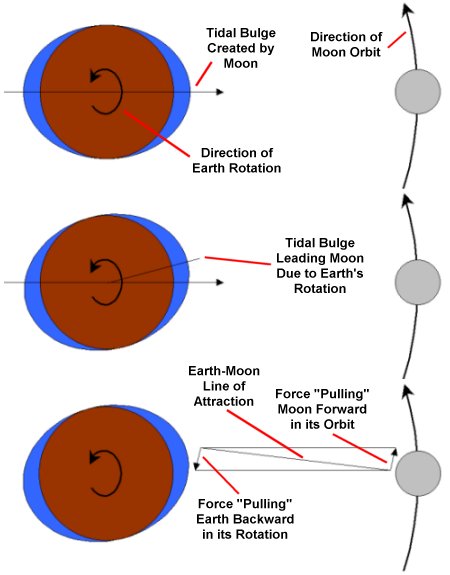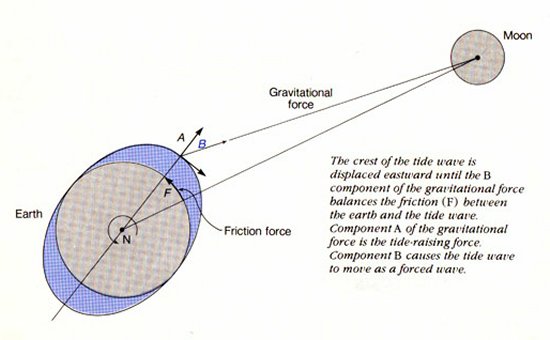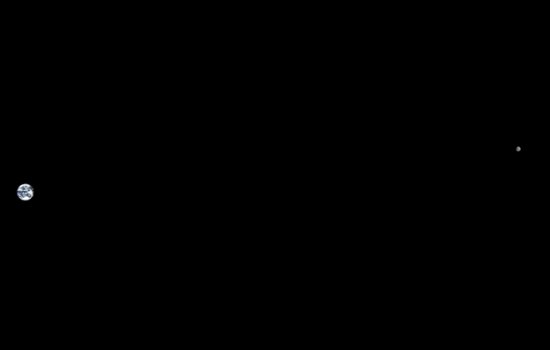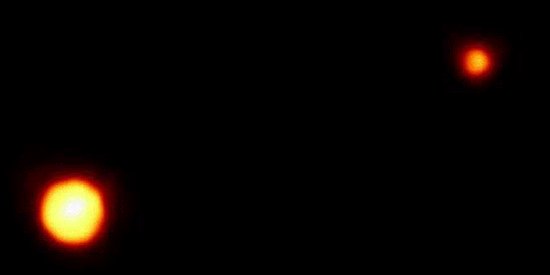|
||||||||||
|
|
||||||||||
|
||||||||||
|
|
||||||||||

The reason the Moon's orbital distance from Earth is gradually increasing is due to the influence of the tides. Tides on Earth are created by the gravitational influence of both the Moon and the Sun that tug on the planet and cause it to bulge outward slightly at the equator. The majority of this equatorial bulging is actually due to the rotation of the Earth about its axis. This rotation raises the equator about 23 kilometers, or 0.4% of the Earth's radius, higher than it would be if the Earth did not rotate. The planet's shape is further deformed by the gravitational pull of the Moon. While the solid surface of the Earth is distorted by only a few centimeters, the primary effect is on the oceans that rise by a few meters.

One might expect that the tidal bulge created by the Moon's gravitational attraction would point directly at the Moon. This would be the case if the Earth rotated about its axis at the same rate as the Moon orbits around the Earth. We know that this is not the case since the Earth makes a complete rotation about its axis in only 24 hours while it takes 27.3 days for the Moon to make a complete rotation around the Earth. Because of this difference in rotation speeds, the tidal bulge created by the Moon actually rotates ahead of the Moon in its orbit by about 3 degrees.
Since the bulge leads the Moon in its orbit, its gravitational attraction on the Moon pulls the Moon forward. This effect increases the Moon's energy to resist the gravitational attraction of the Earth. The increase in energy allows the Moon to pull further away from Earth and increase its orbital distance. As its distance increases, the Moon's orbital speed decreases according to the law of conservation of angular momentum.

Scientists have estimated the rate at which the Moon's orbit is increasing by studying fossil deposits left by the tides over long periods of time. A more accurate measurement is also available thanks to Apollo astronauts who placed corner cube reflectors on the lunar surface in the 1970s. By bouncing laser beams off these reflectors, scientists can obtain a very precise distance to the Moon. Both methods have shown that the Moon's orbit is increasing by 3.8 centimeters (1.5 inches) per year. The fossil records further indicate that this rate has remained nearly unchanged for the past 900 million years.
Within 500 million to one billion years, however, the Moon will have moved far enough from Earth that total eclipses of the Sun will no longer be possible for observers here on Earth. By this time, the Moon will have moved about 5% further from Earth than it is today and will be too small to completely cover the disk of the Sun. Any solar eclipse that occurs after this time will be only a partial eclipse.

The tidal effect is not only causing the Moon to move further away from Earth but is also slowing the Earth down. While the tidal bulge leads the Moon and pulls it forward, the Moon also exerts a gravitational attraction on the tidal bulge that pulls it backward. As the ocean waters are pulled across the ocean floor, friction is created that slows the Earth's rate of rotation about its axis. This effect slows the Earth's rotation by 0.0018 seconds, or about two milliseconds, per century.
This process began billions of years ago once the Earth and Moon had formed. The rate at which the Moon's orbit increased was faster then given the Moon's closer location to Earth. As the tidal effect caused the Moon to spiral outward, its own rotation rate was decreased until the Moon always showed the same face to Earth. The Moon was slowed much more rapidly given its much smaller size compared to Earth. It is estimated that the Moon's rotation stopped within about 50 million years of its formation.

This same phenomenon continues today as the tides slow Earth's rate of rotation. If allowed to continue to its conclusion, the length of a day on Earth and the time it takes for the Moon to orbit the Earth will equalize to about 55 days. Once that occurs, the Earth will always present the same face to the Moon just as we on Earth can only see one side of the Moon. The tidal bulge that now leads the Moon will instead point directly at the Moon and the Moon will stop moving further away from Earth. This process is known as tidal locking and is a common occurrence between other bodies in the solar system.

Probably the closest parallel to the Earth-Moon system is Pluto and its moon Charon. Both bodies are much smaller
than the Earth and Moon, but Charon is relatively much larger in comparison to Pluto since it is about 50% the size
of the planet it orbits. Given their much closer relative sizes, Pluto and Charon became tidally locked in much
less time than it will ultimately take the Earth and Moon to do so.
- answer by Justine Whitman, 19 February 2006
Read More Articles:


|
Aircraft | Design | Ask Us | Shop | Search |

|
|
| About Us | Contact Us | Copyright © 1997-2023 | |||
|
|
|||